As a stage in the evolution of safe and successful methods of reproduction, there’re a few issues with eggs. There are also many strategies that birds have adopted to negate these issues.
As an exercise in biophysics and biochemistry, there is simply nothing better than an egg. Sure, there are challenges in ovipary (egg-laying) as a reproductive strategy, but millions of years of evolution have led to an egg as a rather astounding structure, physically, chemically and æsthetically.
First, the challenge. Mammals
have pretty much perfected the process of ensuring the next generation by
retaining their offspring within the maternal body, being kept warm and safe by
the parent with experience and skills to stay secure from predators. Carrying
within the body a number of developing offspring isn’t an option for an animal
that flies, that’s a considerable weight to carry around. Forming an egg and
then passing it out of the body is the avian
solution to this problem. Even in a relatively undeveloped state, before the
eggs are laid, there’s still a handicap in the weight of the eggs. Particularly
for birds that rely on flight to catch prey, breeding time could be
problematic. If you cannot fly fast and long, you go hungry and your eggs don’t
mature. In falcons, goshawks and other birds of prey, the female is larger than
the male for a beneficial readjustment of the power to weight ratio. Females
are often noticeably larger than males. In fact, a female peregrine , a
‘tiercel’, a word derived from archaic French meaning ‘one third larger’, can
carry developing eggs and still hunt on the wing.

Peregrine falcons at the eyrie – the tiercel (left) and the smaller male
With the eggs completing development out in the variable external environment, a number of challenges follow. They have to be kept warm and they have to be kept secure. A nest serves as a response to both of these challenges.
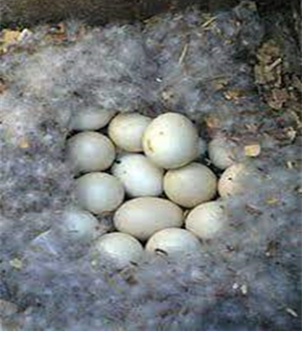
Down nest-lining and large clutch of a Wood duck
Lined with heat-retaining feathers or fine grasses, the incubating parent passes their body heat to the eggs. The nest provides an insulated environment against the temperature variations that might otherwise stop fœtal development.
For security, the nest might be completely enclosed, contained within a hollow, a tunnel in an earth bank or a stick or grass dome with a small side entrance. It might be a suspended cup, entwined in the outer foliage of a bush or tree that would not support the weight of a foraging monitor or possum. It could be concealed within the spiky defences of a clump of porcupine grass or thorn-encrusted thickets of shrubs.
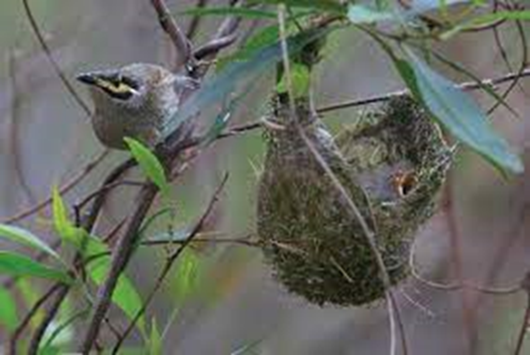
A Yellow-faced honeyeater builds a suspended ‘cup’ in the outer foliage
Nest building requires energy and resources and some species just don’t do it or if they do, they do it rather sparingly. For pigeons and cooing doves, it is a case of ‘two sticks across and a little bit of moss, and that will doo, doo doo.’
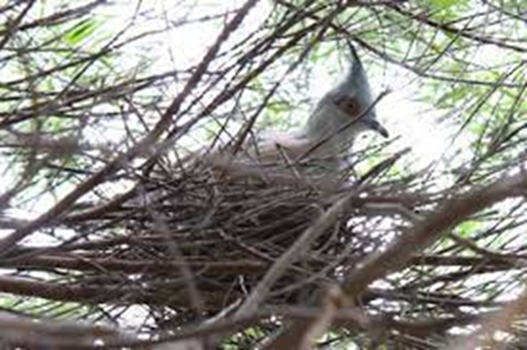
The flimsy nest of a Crested pigeon
Frogmouths will never win awards
for excellence in nest building either, with just a few twigs laid out on a
horizontal fork in a sturdy gum where at least there is little swaying, even on
a strong breeze. Cuckoos don’t even bother, they simply parasitise the nests of
others and foster out
Some birds of prey take over the nests of ravens for their own use. Other species, including lapwings, dotterels, and terns use a scrape in the ground, sometimes lined, sometimes not. For them, security is a mix of concealment and parental defence.
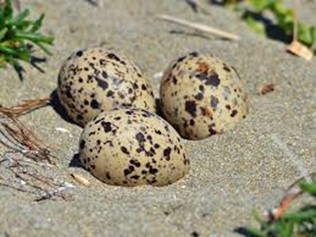
The ‘no’ nest of the pied oystercatcher
But back to the egg, a structure largely composed of insoluble calcium carbonate, inside of which the embryo develops in a fluid environment. Gasses pass through a semi-permeable shell and internal membranous sacs isolate the nitrogenous wastes from protein synthesis. Creating the shell requires energy and resources.
A sphere can enclose the greatest volume within the least surface area. It is least wasteful of energy and resources for a bird to have a spherical egg. If the egg is laid on the ground or on a flattish platform of twigs, it can readily roll around – and away. Birds that build in hollows, where there is nowhere to roll to, can afford to produce spherical eggs. This is the shape of eggs of parrots and kingfishers, both hollow-nesting species, or rainbow birds, which nest at the end of a metre-long tunnel in sand.
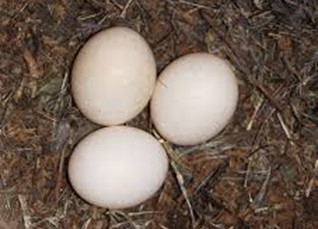
Near-spherical eggs of a hollow-nesting eastern rosella
A clutch of spherical eggs clumped together will necessarily leave gaps in between where they touch. If the incubating bird is trying to cover all of the eggs with their body warmth, spheres aren’t the best shape.
Reflect on how the wedges of a pizza fit together. Conical-shaped eggs can be gathered with their pointed ends inwards to provide the best opportunity for each to receive parental warmth as more eggs will fit under the bird.

The conical egg of a painted snipe
If they were to roll, it wouldn’t be away, it would be around and the parent bird can simply nudge them together again.
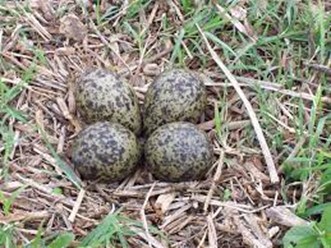
Masked lapwing – pointed ends in
There are further advantages to nesting in hollows. Not only are eggs the most efficient shape, they also don’t need to be camouflaged. In fact, the advantage is in dispensing with the production of pigment altogether, as a white egg is easier for the bird to see when it enters the darkened hollow. Further, safety from predators is greater when the eggs are so hidden and defence by the parents is simpler.
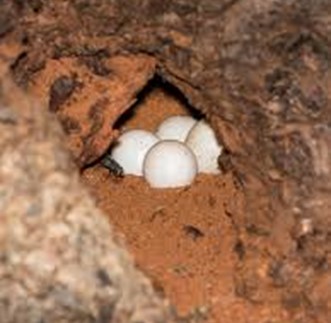
White spherical eggs of the hollow-nesting Sacred kingfisher
There is some great architecture in bird nests. Australia has a number of mound-builders, where mallee fowl and scrub turkeys lay their large number of eggs in a heap of decaying vegetation, harnessing the heat of decomposition for incubation. Mudlarks, choughs, swallows and fairy martins build quite elaborate mud-nests, as bowls or bottles, in which to lay. The large bowl of a white-winged chough will have the many eggs of the extended family group.
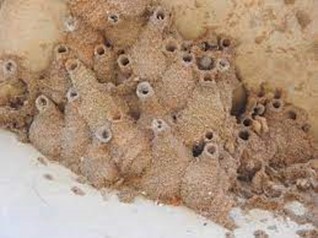
Mud nests of Fairy martins, known to many as Bottle swallows
If the nest is on the ground, the trade-off is between reduced effort in nest-building and greater vulnerability to predation. The first line of defence is camouflage. An egg with colours and patterns that blend into the background provides some advantage against predators. The biochemical pathways that result in background egg-colour, then coloured blotches and streaks need inputs and energy but the payback will be eggs that are hard to see and so more likely to result in successful fledging.
The second line of defence is up to the parent birds. Fierce defence of the eggs and young is a strategy of many species. Masked lapwings were previously known as Spur-winged plovers for the sharp spur on the elbow joint of the wing. This is a spur to avoid as the lapwing dives at whoever or whatever approaches the nest. Magpies can make parks dangerous places in Spring as they swoop pedestrians who stray within their territory. Swans can be quite frightening in attack if the personal space of their cygnets is invaded. Miners, mudlarks and willy wagtails appear fearless as they mob and drive off currawongs, raven and eagles, many time their size.
Rather than drive away predators, some species lure them away. If a Red-capped plover thinks the eggs and/or chicks are in danger, it will lead a predator away by posing as an easy meal through having a broken wing and take the threat away from the nest, only to fly off and around when the danger has been sufficiently reduced.
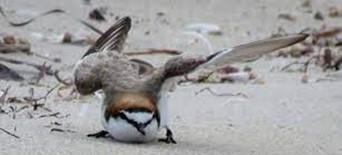
The broken wing display of a Red-capped plover
Of course, unprotected eggs or vulnerable chicks are an easy meal for a scavenging gull or a candidate for squashing by a beach-driven 4WD. An off-leash dog also will scare off a parent bird to leave the eggs or young exposed.
A third strategy is in the number of eggs. It is common for emus, ducks and geese to produce at least 10 eggs, accepting that not all will survive to fledging. It has been estimated that the success rate from egg to independence is around 5%. We’d be swamped by birds if all eggs laid were to develop through to adult birds so food chains in which birds appear as intermediate links are simply a feature of the natural world.
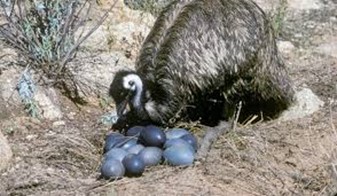
The typically large clutch that the male emu incubates
And finally, many species are opportunistic breeders, if the food resource is there, they will have second and third broods. In a good season, willie wagtails will keep up a production line of young to spill over the tightly-woven, spiderwebbed, cup-shaped nest.
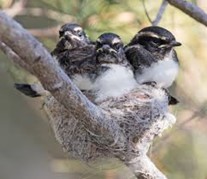
Willie wagtails build a tightly-woven cup of cobwebs and fine grasses
There’s considerable energy invested in reproduction and egg-layers, as do all species, want to see a return on that investment. Accordingly, there is a plethora of adaptations to maximise that return. Approaching the matter from first principles is a fine way to understand these adaptations and appreciate how birds reproduce.